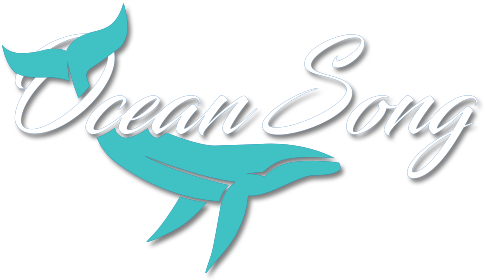Grand Bahama to The Berry Islands
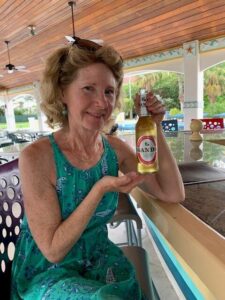
Girl with a Bahamian Beer
We arrived at Grand Bahama Island on Wednesday, April 26th. We spent three nights at the Grand Bahama Yacht Club in Lucaya. It was nice to be in a marina, we gave Ocean Song a much-needed cleaning and had some very good meals at the Yacht Club restaurant and a Greek restaurant, Zorbas, at the Port Lucaya Marketplace. There were lots of cruise ship folks shopping, dining, and just hanging out – with their green and white beach towels over their shoulders.
We left the marina on Saturday morning and motored about 7nm to Topgallant Basin off the Lucayan Waterway. The forecast was for Gale force winds on Sunday. We thought Topgallant would be a good foul-weather anchorage. The marina was fine, but we didn’t like the fixed concrete docks and questionable cleats in high winds.
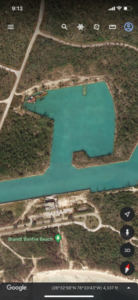
Topgallant Basin
The Lucayan Waterway traverses Grand Bahama roughly N to S. A failed development on the southern end of the waterway created a series of canals and basins that are essentially abandoned. The development was started in the 1960’s and through fits and starts stalled almost completely 25 – 30 years ago. Our neighbors in Topgallant were a small sunken sailboat, and 3 derelict boats, a fishing boat, a dive boat, and a work boat. There was also a crane on a barge and a large work platform. The derelict (and partially sunken) boats had been there for years. We wondered if they had been taken there to ride out a hurricane or simply abandoned there.
On Sunday we had Gale force winds most of the day, but we had the entire basin to ourselves. Ocean Song was well-anchored and other than swinging with wind shifts she stayed safely in place. Topgallant was not picturesque, but it was a good storm anchorage. From our anchoring spot we could see a large, abandoned hotel, very creepy.
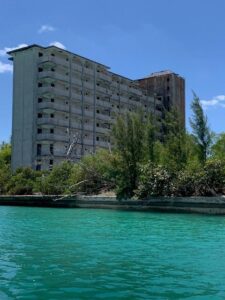
The abandoned Arawak Hotel
With some help from Google, we learned it was the Arawak Hotel and it had been abandoned for more than 25 years. On Monday we took a dinghy trip up the waterway and found several abandoned properties, sunken boats, and a few very nice homes that are still occupied.
We brought up the anchor at 7:00 am on Tuesday, May 2nd and headed for the Berry Islands. Our initial destination was Slaughter Harbour, not an appealing name but a good one-night anchorage. The large anchorage is between Little Stirrup Cay (owned by Royal Caribbean Cruise Lines) and Big Stirrup Cay (owned by Norwegian Cruise Line). The two islands are private so we couldn’t go ashore but our intentions were to stay onboard anyway so it didn’t matter.
We had our best day sailing since owning Ocean Song! The seas were swelly at first but flattened out by 10:00 am.
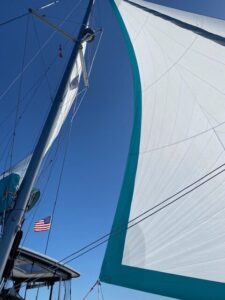
Our Screecher
We put up our screecher (a very large sail, flown from our bowsprit) on a starboard tack and had great speeds. The wind was from 9 – 14 knots on the beam. We had speeds from 6.8 knots to 9.4 knots.
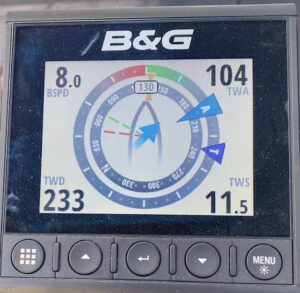
8 Knots of boat speed in 11.5 knots of wind is pretty darn good!
We were consistently sailing between 7.5 – 8.5 knots in 10 – 12 knots of wind. On a boat that weighs in at 30,000 pounds, the ability to sail at 65% -75% of wind speed is pretty incredible. Without the screecher we would have never been able to sail at more than 6.5 knots in those winds. With the screecher up we easily averaged about 7.8 knots over the ground.
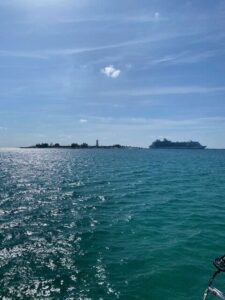
The cruise ships look bigger than the island.
As we approached our anchorage, the two cruise ships docked at the pier looked bigger than the island behind them. We anchored in very shallow water, about 6 – 8 feet. Linda and I dove on the anchor, swam around our likely swing radius, and felt we had found a good spot. It turned out there was a lot of choppy wave action all night, so it wasn’t easy to sleep. Again, Ocean Song’s anchor held firm, and we had a safe (but noisy) night. We will now head to Bullock’s Harbour on Great Harbour Cay to do some provisioning. We’ll have to do some research but let’s think about this… Slaughter Harbour, Bullock Harbour, I think somebody may have killed a cow or two around here in the past.
